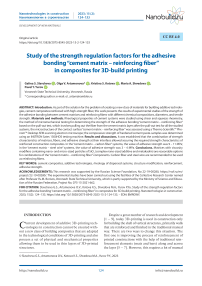Study of the strength regulation factors for the adhesive bonding “cement matrix – reinforcing fiber” in composites for 3D-build printing
Автор: Galina S. Slavcheva, Olga V. Artamonova, Kristina S. Kotova, Maria A. Shvedova, Pavel Y. Yurov
Журнал: Nanotechnologies in Construction: A Scientific Internet-Journal @nanobuild-en
Рубрика: Development of new polymer materials
Статья в выпуске: 2 Vol.15, 2023 года.
Бесплатный доступ
Introduction. As part of the solution for the problem of creating a new class of materials for building additive technologies, cement composites reinforced with high-strength fiber, this work presents the results of experimental studies of the strength of the adhesive bonding between cement matrices and reinforcing fibers with different chemical compositions, diameters, and tensile strength. Materials and methods. Rheological properties of cement systems were studied using shear and squeeze rheometry, the method of micromechanical testing for determining the strength of the adhesive bonding “cement matrix – reinforcing fiber” based on the pull-out test, which involves pulling out the fiber from the cement matrix layer; after the pull-out test for all the studied systems, the microstructure of the contact surface “cement matrix – reinforcing fiber” was assessed using a Thermo Scientific™ Phenom ™ Desktop SEM scanning electron microscope; the compressive strength of hardened cement paste-samples was determined using an INSTRON Sates 1500HDS testing machine. Results and discussions. It was established that the combination of strength characteristics of matrices, fibers, and adhesive strength at their interface allowed securing the required strength characteristics of reinforced construction composites. In the “cement matrix – carbon fiber” systems, the value of adhesive strength was 9 – 11 MPa; in the “cement matrix – steel wire” systems, the value of adhesive strength was 3 – 4 MPa. Conclusions. Matrices with viscosity modifiers containing nano- and micro-sized particles of SiO2 (complex nano-sized additive and metakaolin) are reasonable options for combinations of the “cement matrix – reinforcing fiber” components. Carbon fiber and steel wire are recommended to be used as reinforcing fibers.
Cement composites, additive technologies, rheology of dispersed systems, structure modification, reinforcement, adhesive strength
Короткий адрес: https://sciup.org/142237968
IDR: 142237968 | DOI: 10.15828/2075-8545-2023-15-2-124-133
Список литературы Study of the strength regulation factors for the adhesive bonding “cement matrix – reinforcing fiber” in composites for 3D-build printing
- Lu B., Weng Y., Li M., Qian Y. A systematical review of 3D printable cementitious materials. Construction and Building Materials. 2019; 207: 477 – 490. https://doi.org/10.1016/j.conbuildmat.2019.02.144
- Slavcheva G.S., Artamonova O.V. Rheological behavior of 3D printable cement paste: criterial evaluation. Magazine of Civil Engineering. 2018; 84(8): 97 – 108. https://doi.org/10.18720/MCE.84.10
- Slavcheva G.S., Artamonova O.V. Controlling the Rheological Behavior of Mixtures for Construction 3D Printing: An Experimental Evaluation of the Possibilities of the “Nano” Arsenal. Nanotechnologies in Construction. 2019; 11(3): 325 – 334. https://doi.org/10.15828/2075-8545-2019-11-3-325-334
- Paul S.C., Tay Y.W.D., Panda B., Tan M.J. Fresh and hardened properties of 3D printable cementitious materials for building and construction. Archives of Civil and Mechanical Engineering. 2018; 18(1): 311 – 319. https://doi.org/10.1016/j.acme.2017.02.008
- Ngo T.D., Kashani A., Imbalzano G., et al. Additive manufacturing (3D printing): A review of materials, methods, applications and challenges. Composites Part B: Engineering. 2018; 143: 103. https://doi.org/10.1016/j.compositesb.2018.02.012
- Malaeb Z., Hachem H., Tourbah A., et al. 3D Concrete Printing: Machine and Mix Design. International Journal of Civil Engineering and Technology. 2015; 6(4): 14 – 22.
- Poluektova V.A., Shapovalov N.A. Concrete chemicalization for digital printing: control of rheology and structure formation. Lecture Notes in Civil Engineering. 2021; 95: 59 – 65. https://doi.org/10.1007/978-3-030-54652-6_9
- Perrot A., Jacquet Y., Rangeard D., et al. Nailing of Layers: A Promising Way to Reinforce Concrete 3D Printing Structures. Materials. 2020; 13. P. 1518. https://doi.org/10.3390/ma13071518
- Marchment T., Sanjayan J. Penetration Reinforcing Method for 3D Concrete Printing. In Proceedings of the Second RILEM International Conference on Concrete and Digital Fabrication, Eindhoven. 2020. P. 680 – 690. https://doi.org/10.1007/978-3-030-49916-7_68
- Hass L., Bos F. Bending and Pull-Out Tests on a Novel Screw Type Reinforcement for Extrusion-Based 3D Printed Concrete. In Proceedings of the Second RILEM International Conference on Concrete and Digital Fabrication, Eindhoven. 2020. P. 632 – 645. https://doi.org/10.1007/978-3-030-49916-7_64
- Mechtcherine V., Grafe J., Nerella V.N., et al. 3D-printed steel reinforcement for digital concrete construction—Manufacture, mechanical properties and bond behaviour. Construction and Building Materials. 2018; 179: 125 – 137. https://doi.org/10.1016/j.conbuildmat.2018.05.202
- Weger D., Baier D., Straßer A., et al. Reinforced Particle-Bed Printing by Combination of the Selective Paste Intrusion Method with Wire and Arc Additive Manufacturing—A First Feasibility Study. In Proceedings of the Second RILEM International Conference on Concrete and Digital Fabrication, Eindhoven. 2020. P. 978 – 987. https://doi.org/10.1007/978-3-030-49916-7_95
- Katzer J., Szatkiewicz T. Properties of concrete elements with 3-D printed formworks which substitute steel reinforcement. Construction and Building Materials. 2019; 210: 157 – 161. https://doi.org/10.1016/j.conbuildmat.2019.03.204
- Bos F.P., Ahmed Z.Y., Jutinov E.R., Salet T.A.J.M. Experimental exploration of metal cable as reinforcement in 3D printed concrete. Materials. 2017; 10: 1314. https://doi.org/10.3390/ma10111314
- Slavcheva G.S., Artamonova O.V. Development of principles for creating reinforced composites for building 3D additive technologies. Construction Materials. 2022; 12: 52 – 58. https://doi.org/10.31659/0585-430X-2022-809-12-52-58
- Artamonova O.V. Synthesis of nano-modifying additives for the technology of building composites. Gorod: Voronezh, 2016. – 100 p.
- Slavcheva G.S., Shvedova M.A., Babenko D.S. Analysis and criterion evaluation of the rheological behavior of mixtures for building 3d printing. Construction Materials. 2018; 12: 34 – 40. https://doi.org/10.31659/0585-430X-2018-766-12-34-40
- Gorbatkina Yu.A., Ivanova-Mumzhieva V.G. Adhesion ability of carbon black-filled epoxides. Adhesives. Sealants. Technologies. 2008; 11: 2 – 5.
- Gorbatkina Yu.A. Adhesion strength in polymer-fiber systems. Gorod: Moscow, 1987. – 190 p.


